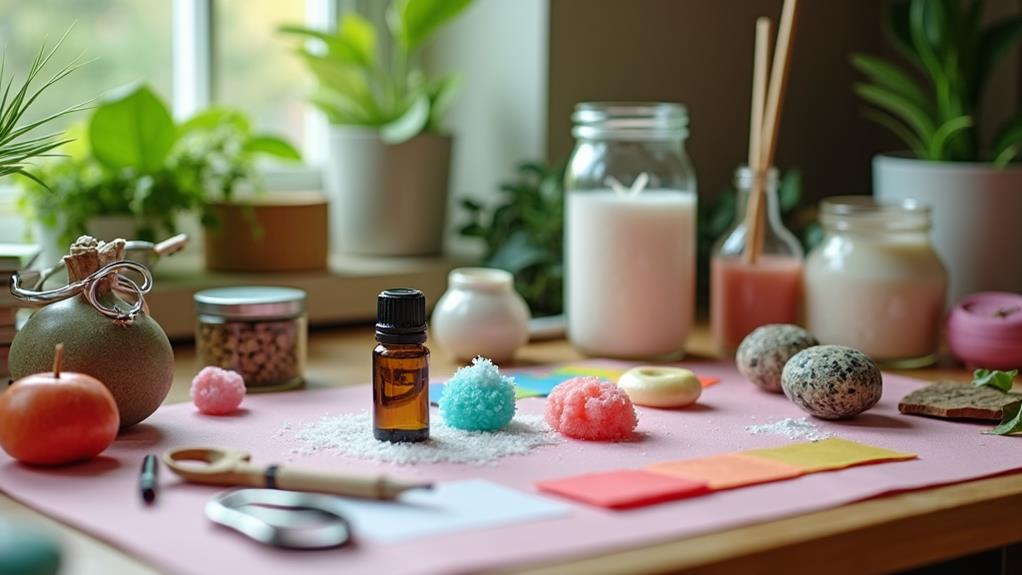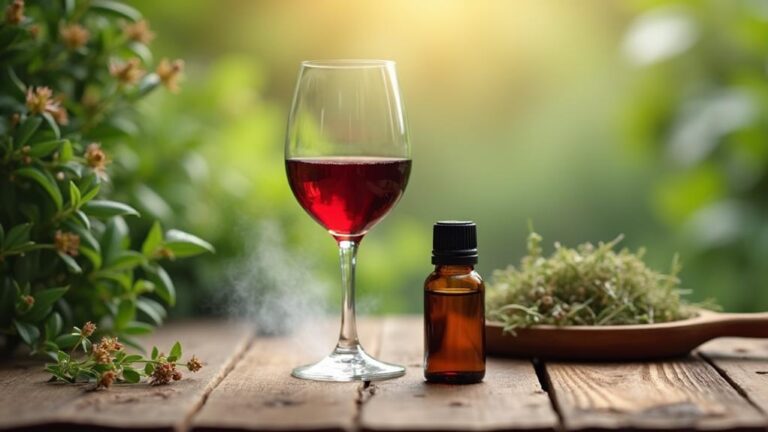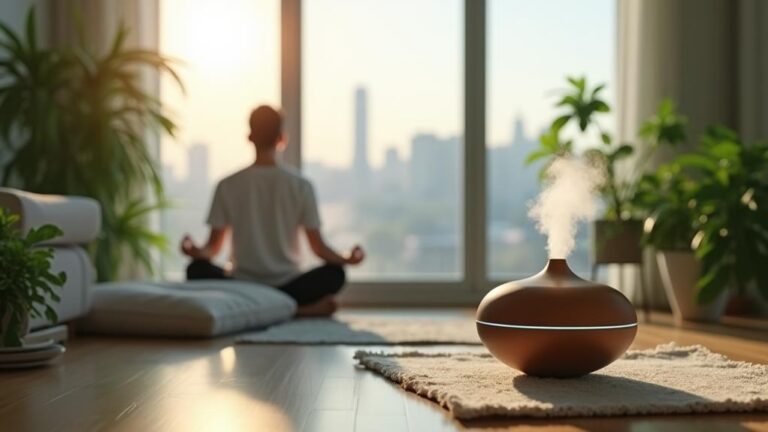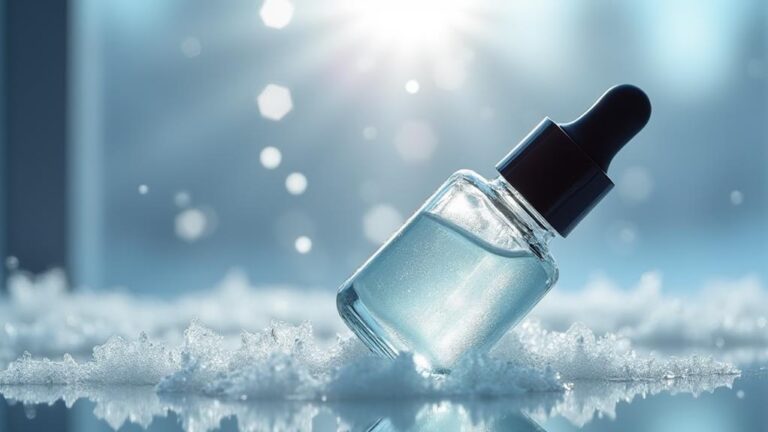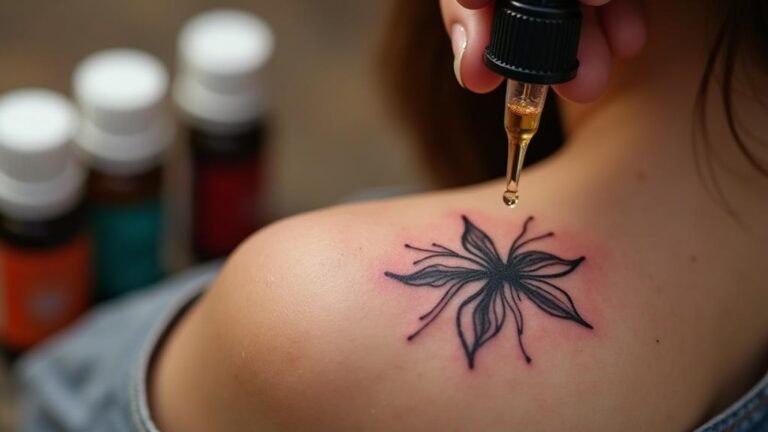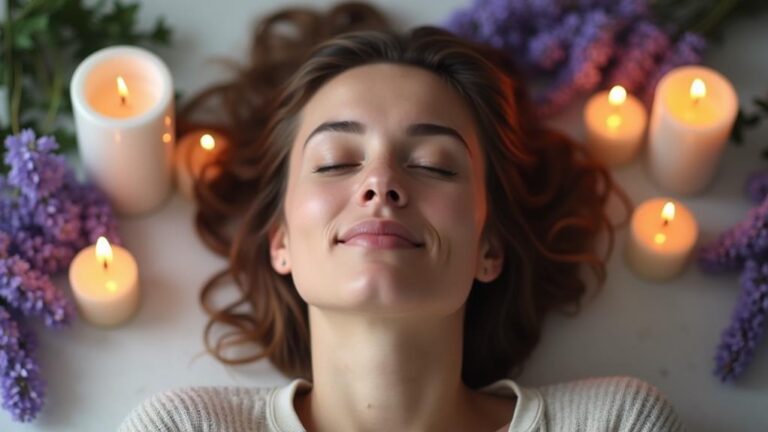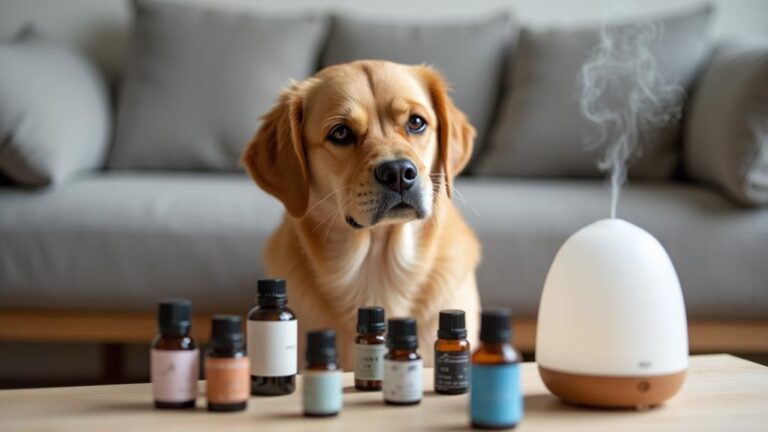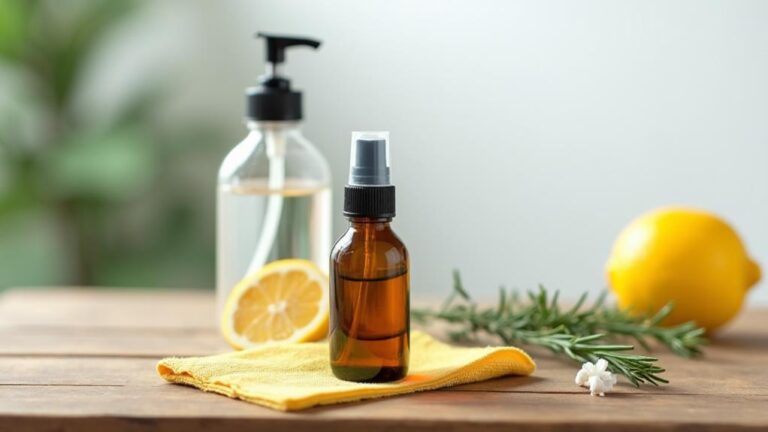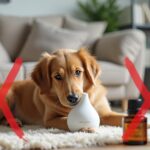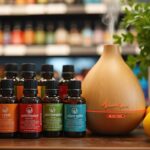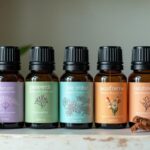You've invested in a collection of essential oils, but now you're left with a surplus. Instead of letting them go to waste, consider repurposing them into creative projects that can benefit your daily life. From natural pest control methods to beauty treatments, the possibilities are vast. You might be surprised at how versatile these oils can be. But where do you start? By exploring the various uses for excess essential oils, you'll not only reduce waste but also discover new ways to enhance your home, health, and well-being. What hidden potential lies within your essential oil collection?
Key Takeaways
- Create a natural insect repellent for gardens by mixing excess essential oils with water and spraying on plants.
- Use excess essential oils to make natural skin toners that balance skin pH and tighten pores.
- Mix excess essential oils with baking soda to create eco-friendly scrubbing agents for cleaning surfaces.
- Add excess essential oils to bath water for a relaxing and rejuvenating soak.
- Use excess essential oils to create a natural fabric softener that reduces static cling and makes clothes feel softer.
Natural Pest Control Methods
Using excess essential oils as natural pest control methods can be a game-changer for your home and garden.
You can create a natural barrier to keep garden pests away from your plants by mixing essential oils with water and spraying it around your garden. For example, peppermint oil can repel ants and aphids, while lemongrass oil can deter mosquitoes and ticks.
For lawn care, you can use essential oils like tea tree oil and lavender oil to control fungal growth and promote a healthy lawn.
You can also use essential oils to control weeds by mixing them with vinegar and water. For instance, clove oil can help control dandelions and other broadleaf weeds.
To use essential oils for pest control, you'll need to dilute them with water and spray them around your garden or lawn.
Always test a small area first to verify the mixture doesn't harm your plants.
You can also add other natural ingredients like garlic and soap to enhance the effectiveness of your natural pest control solution.
Aromatic Room Sprays
One of the simplest and most effective ways to create a cozy atmosphere in your home is by crafting aromatic room sprays with your excess essential oils.
These fragrant mists can be easily customized to suit your preferences by combining different essential oils. To get started, you'll need a spray bottle, water, and your chosen essential oils.
Mix a few drops of the essential oil with water, and you're ready to spritz your way to a calming ambiance. You can create an invigorating citrus scent by combining lemon and grapefruit essential oils, or a soothing lavender and chamomile blend for a relaxing atmosphere.
When crafting your aromatic room sprays, keep in mind that you can also add a touch of vodka or witch hazel to act as a preservative and help the scents last longer.
Experiment with different blends and concentrations to create unique scented fogs that can be used in various rooms, from the bedroom to the living room.
Homemade Cleaning Products
You can repurpose excess essential oils by incorporating them into homemade cleaning products that not only effectively clean but also promote a healthier environment.
Two great uses for essential oils in cleaning products are as natural disinfectant sprays and eco-friendly scrubbing agents.
Natural Disinfectant Sprays
Essential oils can breathe new life into your cleaning routine by transforming them into natural disinfectant sprays. You can easily create these sprays at home using a combination of essential oils and a few other household ingredients.
| Disinfectant Blends | Benefits |
|---|---|
| Tea Tree + Lemon | Antibacterial and antiviral properties |
| Eucalyptus + Peppermint | Decongestant and invigorating properties |
| Lavender + Chamomile | Calming and soothing properties |
| Geranium + Bergamot | Antimicrobial and uplifting properties |
| Cinnamon + Clove | Antibacterial and antifungal properties |
When creating your essential sprays, mix 10-15 drops of your chosen blend with 1 cup of water and 1 tablespoon of white vinegar in a spray bottle. Shake well and use on surfaces, in the air, or on fabrics. Remember to always spot test a small area before using a new spray. You can also customize your sprays by adding other ingredients, such as baking soda or castile soap, to enhance their cleaning power. By using essential sprays, you can keep your home clean and germ-free while also promoting a healthier environment.
Eco-Friendly Scrubbing Agents
Every home generates its share of tough grime and stubborn stains, which is where eco-friendly scrubbing agents come in.
Using excess essential oils, you can create effective homemade cleaning products that not only clean but also nourish your home environment.
To start, you can make a gentle yet potent scrub by mixing baking soda with essential oils like lemon or eucalyptus.
This paste can be used to scrub away grime and stains on surfaces like countertops, sinks, and faucets.
For tougher grime, you can incorporate exfoliating granules like walnut shell powder or pumice into your scrub.
These natural abrasives help break down tough stains without scratching surfaces.
You can also repurpose excess essential oils in soap making by adding them to your soap recipes.
The result is a nourishing soap that not only cleans but also moisturizes your skin.
By using eco-friendly scrubbing agents, you're not only reducing your environmental footprint but also creating a healthier home environment.
With a little creativity, you can turn excess essential oils into effective cleaning tools that promote a cleaner, greener home.
Essential Oil Candles
When creating essential oil candles, you'll first need to choose the right wax, considering factors like melting points, hardness, and eco-friendliness.
Next, you'll want to blend essential oils to create unique scents that promote relaxation, energy, or focus, so mastering how different oils interact with each other is crucial.
Choosing the Right Wax
Selecting the right wax for your essential oil candles is essential, as it directly affects the burn time, stability, and overall performance of the candle.
You have several wax types to choose from, including paraffin, soy, beeswax, and gel wax. Each wax type has its own melting point, which is pivotal in determining the burn time and stability of your candle.
When choosing a wax, ponder the melting point and how it will affect the burn time of your candle.
For example, paraffin wax has a high melting point, making it ideal for container candles, while soy wax has a lower melting point, making it suitable for votive or tealight candles.
Beeswax, on the other hand, has a natural, pleasant scent and a high melting point, making it ideal for pillar candles.
It's also imperative to ponder the hardness and softness of the wax.
A harder wax will produce a cleaner, more consistent burn, while a softer wax may produce a more rustic, textured burn.
Essential Oil Blending Tips
In the domain of essential oil candles, blending tips play a fundamental role in releasing the full potential of your creations.
When combining essential oils, you'll want to ponder the oil profiles and how they interact with one another. This involves looking at the percentage of top, middle, and base notes in each oil. Top notes provide the initial scent, middle notes add depth, and base notes linger longest.
Understanding these profiles helps you balance your blends.
Fragrance families are another pivotal factor in blending. These families include floral, citrus, woody, and spicy, among others.
Grouping oils by their fragrance families allows you to create harmonious blends. For example, combining lavender (floral) with bergamot (citrus) creates a soothing and uplifting scent.
You can also experiment with contrasting fragrance families to add complexity to your blends. By pondering oil profiles and fragrance families, you'll be able to craft unique and enchanting scents for your essential oil candles.
This approach will enable you to tap into the full potential of your creations and produce truly exceptional results.
Customizing the Candle Scent
Customizing the scent of your essential oil candles can be as simple as fine-tuning a recipe or as complex as crafting a completely new fragrance.
You can start by experimenting with scent layering to create unique blends. This involves combining multiple essential oils to achieve a specific effect, such as relaxation or energization.
When layering scents, it is vital to balance top, middle, and base notes to create a harmonious fragrance.
Fragrance profiling is another technique you can use to customize your candle scents. This involves identifying the characteristics of individual essential oils, such as their intensity, duration, and emotional impact.
By understanding the profiles of different oils, you can combine them in ways that create specific moods or effects. For example, you might combine calming lavender with uplifting bergamot to create a relaxing yet energizing scent.
Beauty and Skin Treatments
Your beauty routine can greatly benefit from excess essential oils, and you're likely to discover a multitude of uses for them in this area.
Essential oils can be used to create natural skin toners that balance your skin's pH and tighten pores. For example, you can mix a few drops of witch hazel and tea tree essential oil with water to create a toner that reduces acne and inflammation.
Alternatively, you can use essential oils to make face masks that nourish and rejuvenate your skin. Combine a few drops of lavender essential oil with oatmeal and honey to create a soothing mask that calms irritated skin.
You can also use essential oils to create body scrubs, massage oils, and perfumes. For instance, you can mix a few drops of lemon essential oil with sugar and olive oil to create a scrub that exfoliates and brightens your skin.
Essential oils can also be added to your bath water to create a relaxing and rejuvenating soak. By incorporating essential oils into your beauty routine, you can create natural and effective treatments that promote healthy and glowing skin.
Insect Repellent Sticks
Essential oils can be a vital component in creating effective insect repellent sticks, providing a natural alternative to DEET-based products.
You can combine your excess essential oils with other natural ingredients to create homemade insect repellent sticks that are safe for your skin and the environment.
To make these sticks, you'll need a few simple ingredients, including coconut oil, beeswax, and vitamin E oil.
You can customize the blend by using different essential oils that are known for their insect-repelling properties, such as citronella, lemongrass, and peppermint.
When you're out and about, these insect sticks can be a lifesaver, helping to prevent bug bites and keep you comfortable.
Simply apply the stick to your skin or clothing to create a barrier that repels insects.
You can also use these sticks to protect your gear, such as backpacks and camping equipment, from insects.
By making your own insect repellent sticks, you'll have a convenient and effective way to enjoy the outdoors without worrying about bug bites.
These sticks are also a great alternative to sprays and lotions, as they're easy to apply and don't leave a greasy residue.
Aromatherapy Bath Bombs
When creating aromatherapy bath bombs, you'll first need to choose essential oils that not only provide a pleasant scent but also promote relaxation, reduce stress, or uplift your mood.
Consider selecting oils with complementary properties, such as lavender for calming and chamomile for soothing skin irritations.
As you craft your bath bombs, you'll mix these essential oils with baking soda, citric acid, and other natural ingredients to create a fizzy, fragrant experience.
Choosing Essential Oils
As you start crafting your aromatherapy bath bombs, selecting the right essential oils can be a crucial step in creating a truly rejuvenating experience.
When choosing essential oils, consider their essential properties and how they'll interact with your skin and senses.
You'll want to select oils that not only smell good together but also complement each other's therapeutic benefits.
Consider the following factors when selecting essential oils:
- Oil profiles: Understand the chemical composition of each oil, including its dominant notes and any potential skin irritants.
- Therapeutic benefits: Choose oils that align with your desired outcome, such as relaxation, stress relief, or energy boost.
- Blending compatibility: Consider how the oils will work together, taking into account their intensities and potential synergies.
Crafting Bath Bombs
Crafting bath bombs is an art that requires a harmonious balance of ingredients to create a truly immersive aromatherapy experience.
You'll need baking soda, citric acid, Epsom salt, and your excess essential oils to create fizzy relaxers that melt your worries away. When selecting bath bomb recipes, consider the therapeutic benefits of different essential oils.
For instance, lavender promotes relaxation, while eucalyptus relieves stress and congestion.
To create your bath bombs, mix baking soda, citric acid, and Epsom salt in a bowl. Gradually add your essential oils, stirring well to guarantee even distribution.
You can customize your bath bomb recipes by adjusting the amount of each ingredient and experimenting with different essential oil blends. When you're ready to unwind, simply drop your bath bomb into the water and watch it fizz away, releasing a soothing aroma that calms your mind and body.
With practice, you'll become a master of crafting bath bombs that cater to your unique needs and preferences, making every bath time a rejuvenating experience. By repurposing your excess essential oils, you'll create fizzy relaxers that nourish both body and soul.
Scented Playdough Recipes
Explore the world of creative play by repurposing excess essential oils into scented playdough recipes that'll delight kids and adults alike.
This activity combines sensory integration, fine motor skills, and art therapy, making it a holistic experience for individuals of all ages.
By incorporating essential oils into playdough, you can create unique scents that evoke emotions and stimulate imagination.
To make scented playdough, you'll need a few basic ingredients: flour, water, salt, cream of tartar, and food coloring.
You can customize your recipe by adding different essential oils to create unique scents.
- Calming Lavender Playdough: Add 5-7 drops of lavender essential oil to your playdough recipe for a calming and soothing scent.
- Invigorating Peppermint Playdough: Mix in 5-7 drops of peppermint essential oil for a rejuvenating and revitalizing scent.
- Uplifting Citrus Playdough: Combine 5-7 drops of lemon or orange essential oil with your playdough recipe for a bright and uplifting scent.
Freshening Laundry Tips
You've explored the creative world of scented playdough, now it's time to tackle the often-overlooked task of freshening your laundry.
Using excess essential oils to create a laundry refresher is an effective way to keep your clothes smelling fresh and clean. Simply mix a few drops of your preferred essential oil with water and add it to a spray bottle.
You can then spritz this solution onto your clothes before or after washing to leave a lasting scent.
Essential oils can also be used to create a natural fabric softener.
Combine 1 cup of white vinegar, 1 cup of water, and 10-15 drops of your preferred essential oil in a spray bottle.
Shake the mixture well and spray it onto your clothes during the rinse cycle.
This won't only leave your clothes smelling fresh but also reduce static cling and make them feel softer.
Revitalizing Perfume Recipes
When creating a perfume blend, consider the following:
- *Top notes*: These oils have a strong, immediate scent and are usually used in small amounts. Examples include citrus and mint essential oils.
- *Middle notes*: These oils have a rich, floral scent and are used to add depth to the blend. Examples include rose and lavender essential oils.
- *Base notes*: These oils have a warm, rich scent and are used to anchor the blend. Examples include vanilla and sandalwood essential oils.
Frequently Asked Questions
Can I Mix Essential Oils With Perfume Fragrances?
When mixing essential oils with perfume fragrances, you're exploring scent blending and fragrance layering. You can create unique blends, but verify you test compatibility and ratios to avoid overpowering the fragrance or causing skin irritation.
Are Essential Oils Safe for Pets to Inhale?
You see the case of a cat experiencing tremors after inhaling diffused tea tree oil. When using essential oils around pets, prioritize their safety, as oil toxicity can be fatal; always research pet-safe options first.
Can Essential Oils Expire or Go Bad?
You're checking the shelf life of your essential oils, and wondering if they can expire or go bad. Yes, oils can degrade over time due to oil degradation, affecting their quality, potency, and safety.
Are All Essential Oils Safe for Skin Application?
Be cautious, for some essential oils can be skin saboteurs. Not all oils are safe for skin application, as they can trigger skin sensitivities and allergic reactions, so always dilute and patch test before using.
Can I Store Essential Oils Near Direct Sunlight?
You shouldn't store essential oils near direct sunlight, as it can cause Sunlight Effects that lead to Oil Degradation, reducing their potency and shelf life, so keep them in a cool, dark place instead.
Conclusion
As you tap the full potential of your excess essential oils, imagine your home transforming into a vibrant garden – every room a blooming flower, every space a haven of serenity and wellness. With each creative project, you're nurturing growth, pruning waste, and cultivating a more holistic lifestyle. Your essential oils, once excess, now blossom into a symphony of natural pest control, beauty treatments, and calming ambiance, filling your life with purpose and fragrance.


